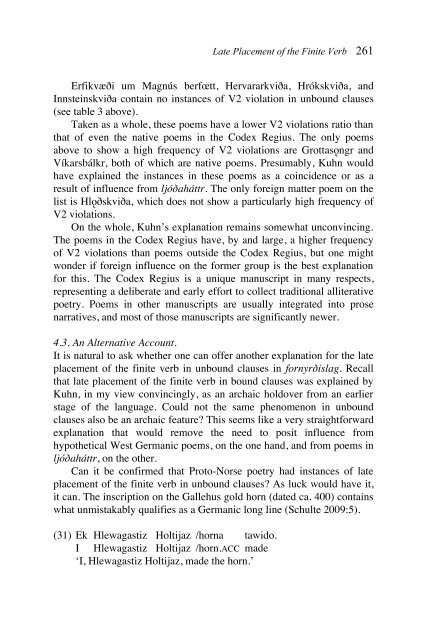Journal of Germanic Linguistics Late Placement of the Finite Verb in ...
Journal of Germanic Linguistics Late Placement of the Finite Verb in ...
Journal of Germanic Linguistics Late Placement of the Finite Verb in ...
Create successful ePaper yourself
Turn your PDF publications into a flip-book with our unique Google optimized e-Paper software.
<strong>Late</strong> <strong>Placement</strong> <strong>of</strong> <strong>the</strong> <strong>F<strong>in</strong>ite</strong> <strong>Verb</strong> 261<br />
Erfikvæi um Magnús berfœtt, Hervararkvia, Hrókskvia, and<br />
Innste<strong>in</strong>skvia conta<strong>in</strong> no <strong>in</strong>stances <strong>of</strong> V2 violation <strong>in</strong> unbound clauses<br />
(see table 3 above).<br />
Taken as a whole, <strong>the</strong>se poems have a lower V2 violations ratio than<br />
that <strong>of</strong> even <strong>the</strong> native poems <strong>in</strong> <strong>the</strong> Codex Regius. The only poems<br />
above to show a high frequency <strong>of</strong> V2 violations are Grottasngr and<br />
Víkarsbálkr, both <strong>of</strong> which are native poems. Presumably, Kuhn would<br />
have expla<strong>in</strong>ed <strong>the</strong> <strong>in</strong>stances <strong>in</strong> <strong>the</strong>se poems as a co<strong>in</strong>cidence or as a<br />
result <strong>of</strong> <strong>in</strong>fluence from ljóaháttr. The only foreign matter poem on <strong>the</strong><br />
list is Hlskvia, which does not show a particularly high frequency <strong>of</strong><br />
V2 violations.<br />
On <strong>the</strong> whole, Kuhn’s explanation rema<strong>in</strong>s somewhat unconv<strong>in</strong>c<strong>in</strong>g.<br />
The poems <strong>in</strong> <strong>the</strong> Codex Regius have, by and large, a higher frequency<br />
<strong>of</strong> V2 violations than poems outside <strong>the</strong> Codex Regius, but one might<br />
wonder if foreign <strong>in</strong>fluence on <strong>the</strong> former group is <strong>the</strong> best explanation<br />
for this. The Codex Regius is a unique manuscript <strong>in</strong> many respects,<br />
represent<strong>in</strong>g a deliberate and early effort to collect traditional alliterative<br />
poetry. Poems <strong>in</strong> o<strong>the</strong>r manuscripts are usually <strong>in</strong>tegrated <strong>in</strong>to prose<br />
narratives, and most <strong>of</strong> those manuscripts are significantly newer.<br />
4.3. An Alternative Account.<br />
It is natural to ask whe<strong>the</strong>r one can <strong>of</strong>fer ano<strong>the</strong>r explanation for <strong>the</strong> late<br />
placement <strong>of</strong> <strong>the</strong> f<strong>in</strong>ite verb <strong>in</strong> unbound clauses <strong>in</strong> fornyrislag. Recall<br />
that late placement <strong>of</strong> <strong>the</strong> f<strong>in</strong>ite verb <strong>in</strong> bound clauses was expla<strong>in</strong>ed by<br />
Kuhn, <strong>in</strong> my view conv<strong>in</strong>c<strong>in</strong>gly, as an archaic holdover from an earlier<br />
stage <strong>of</strong> <strong>the</strong> language. Could not <strong>the</strong> same phenomenon <strong>in</strong> unbound<br />
clauses also be an archaic feature? This seems like a very straightforward<br />
explanation that would remove <strong>the</strong> need to posit <strong>in</strong>fluence from<br />
hypo<strong>the</strong>tical West <strong>Germanic</strong> poems, on <strong>the</strong> one hand, and from poems <strong>in</strong><br />
ljóaháttr, on <strong>the</strong> o<strong>the</strong>r.<br />
Can it be confirmed that Proto-Norse poetry had <strong>in</strong>stances <strong>of</strong> late<br />
placement <strong>of</strong> <strong>the</strong> f<strong>in</strong>ite verb <strong>in</strong> unbound clauses? As luck would have it,<br />
it can. The <strong>in</strong>scription on <strong>the</strong> Gallehus gold horn (dated ca. 400) conta<strong>in</strong>s<br />
what unmistakably qualifies as a <strong>Germanic</strong> long l<strong>in</strong>e (Schulte 2009:5).<br />
(31) Ek Hlewagastiz Holtijaz /horna tawido.<br />
I Hlewagastiz Holtijaz /horn.ACC made<br />
‘I, Hlewagastiz Holtijaz, made <strong>the</strong> horn.’

















